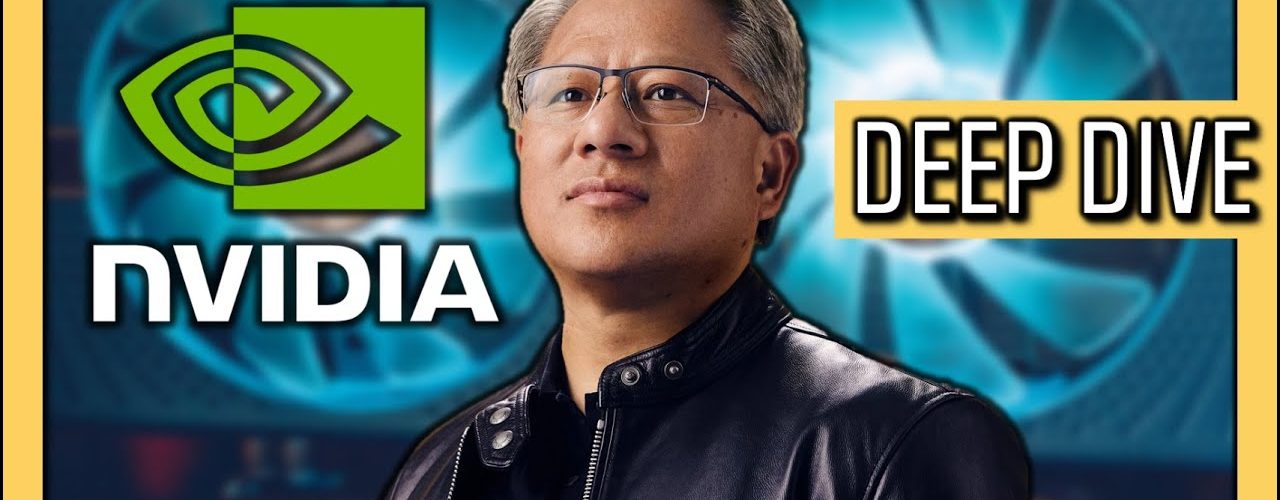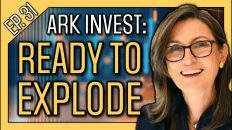Mentioned in Video:
- 🤩 TOP 4 Metaverse Stocks to Buy Now! (Beating Meta & Facebook Stock) ▶ https://www.youtube.com/watch?v=phW4-AqNkGU
- GTC November 2021 Keynote with NVIDIA CEO Jensen Huang ▶ https://www.youtube.com/watch?v=jhDiaUL_RaM
- Nvidia's Investor Relations ▶ https://investor.nvidia.com/home/default.aspx
- Support the channel and get extra member-only benefits by joining us on Patreon: https://www.patreon.com/tickersymbolyou
🧠 #Nvidia (#NVDA stock) could one day be the biggest company ever and one of the best tech stocks. They dominate many different markets, including cloud computing, supercomputing, artificial intelligence, and many more. Want to learn how one company can be so useful to so many different industries? This video explains how Nvidia does it and why Nvidia stock could be one of the best stocks to buy now.
Video Transcript:
0:00
it's tough to think of a more important
0:01
industry today than computing or when we
0:03
depend on more in our daily lives
0:05
microchips are used in countless
0:07
applications from cell phones and solar
0:09
panels to satellites and self-driving
0:11
cars this year alone the global chip
0:13
industry could bring in around 600
0:15
billion dollars and by 2030 spending on
0:17
artificial intelligence ships alone
0:19
could close in on 2 trillion dollars per
0:21
year the competition for this market has
0:24
been turned up to 11. with multiple
0:26
trillion dollar companies like amazon
0:28
microsoft and google all starting to
0:30
design their own chips but it could be
0:32
that none of these tech giants will sit
0:34
on the computing throne actually the
0:36
number one contender weighs in at just
0:38
under 600 billion dollars of market cap
0:42
which is one quarter of the size of
0:44
microsoft the company i'm talking about
0:46
is nvidia and there are three key
0:48
reasons why it might dominate this
0:49
market over the next decade your time is
0:51
valuable so let's get right into it
0:54
nvidia is known for their graphics
0:55
processing units or gpus when most
0:58
people think of nvidia's graphics cards
1:00
they probably think of nerds playing
1:01
computer games that's for a pretty good
1:03
reason as of late last year nvidia had a
1:06
dominant 83 percent of the market share
1:08
for discrete gpus with amd owning the
1:11
other 17
1:12
that means that nvidia sells five out of
1:14
every six graphics cards if you look at
1:17
all gpus sold last year instead of just
1:19
separate graphics cards amd and intel's
1:22
chip shipments were both down by double
1:23
digits due to a global chip shortage
1:26
ouch but nvidia's overall shipments were
1:28
up eight percent here's the thing even
1:30
though nvidia is dominating that market
1:33
it's not the only one they operate in
1:35
over the past few years nvidia has
1:36
branched out from gaming into areas like
1:38
data science artificial intelligence
1:41
modeling and simulation and even edge
1:42
computing that last one is important
1:44
because the smaller nvidia can make its
1:46
chips the closer to the edge of the
1:48
connected world they can get devices at
1:50
the edge are much cooler than just cell
1:52
phones they're things like drones and
1:54
delivery robots and autonomous cars
1:56
pretty much everything i talk about on
1:57
this channel but you don't win the chip
1:59
market by making the smallest chips you
2:01
win it by making the best solutions to
2:03
real problems for the best price and if
2:06
you want to understand how nvidia is
2:07
doing that you need to know what kinds
2:09
of problems gpus solve that cpus aren't
2:12
really built for in my eight years as a
2:14
researcher at mit i worked on a lot of
2:16
programs and prototypes that use gpus
2:18
for a wide variety of tasks here are
2:21
some of my biggest takeaways gpus are
2:23
really good at something called linear
2:25
algebra instead of working with single
2:27
numbers this special area of math works
2:29
with sets of numbers called vectors
2:30
matrices and tensors if that sounds
2:33
absolutely terrible to you that's
2:35
because it is i still have nightmares
2:37
about this stuff from grad school
2:38
despite being the stuff of nightmares
2:40
this special math is the best way to
2:42
solve many similar problems in parallel
2:44
for example if i'm playing a video game
2:46
and i want to move around every surface
2:48
of every object in the scene needs to
2:50
adjust depending on my avatar's position
2:53
and orientation instead of doing that
2:55
math problem object by object for each
2:57
player in a scene developers can just
2:59
build digital environments then those
3:01
graphics get loaded into a gpu that can
3:04
translate rotate and scale everything
3:06
depending on the positions and the
3:07
pointing vectors that you give it for
3:09
each player well it turns out that
3:11
solving many similar problems in
3:12
parallel this way is useful for way more
3:14
than just gaming think about an
3:16
autonomous vehicle that needs to process
3:18
many cameras and radar feeds as it
3:20
navigates through a real environment
3:22
that's kind of like a video game except
3:24
you have eyes all over the body and the
3:26
danger is very real
3:27
wait is this just an episode about all
3:29
of my nightmares think about all the
3:31
graphical applications this type of math
3:33
can be used for drones in the sky
3:35
telescopes trying to find a specific
3:37
object facial recognition social media
3:40
filters the list goes on and on here's
3:42
the thing tensor math isn't just useful
3:44
for graphics you can use this kind of
3:46
math to solve many kinds of problems you
3:48
can build a matrix of how genes express
3:50
themselves in a wide variety of diseases
3:52
for medical diagnostics or you can solve
3:55
a bunch of valuation models at once for
3:57
every stock on the market how about
3:59
trying to solve the same hard
4:00
cryptographic problem using many
4:02
different guesses at the same time
4:04
that's crypto mining what about scoring
4:06
pieces of content for different users
4:08
based on their interests and showing
4:09
them whatever scores the highest in the
4:11
matrix that's a content recommender
4:13
system like netflix or spotify the
4:15
company with the best parallel number
4:17
crunching solution is going to win the
4:19
lion's share of the computing market for
4:21
all these different verticals that need
4:23
this same type of system one big reason
4:25
nvidia is outselling competitors like
4:27
amd five to one is how they handle more
4:30
complex and power-hungry computing tasks
4:32
like ray tracing reflections and
4:34
upscaling graphics at a high level
4:37
there's a big fundamental difference in
4:38
how nvidia and amd build their chips amd
4:41
puts a physical ray accelerator onto
4:43
each core of their gpus it's kind of
4:46
like a supercharger but for computer
4:47
chips instead of cars i'm just kidding i
4:50
don't know anything about cars nvidia's
4:52
specialized ray tracing cores are
4:54
physically separate from their other gpu
4:56
cores nvidia has another special type of
4:58
core called the tensor core because they
5:01
focus on doing this tensor math very
5:03
very fast at the cost of accuracy then
5:06
nvidia fixes those inaccuracies
5:07
separately using deep learning super
5:10
sampling or dlss which is a major
5:12
selling point for their products for
5:14
dlss they train an artificial
5:16
intelligence model on high resolution
5:18
scans of every video game then apply
5:20
that ai to adjust the output of the
5:22
tensor cores to a player's version of
5:24
that same game nvidia's secret sauce is
5:27
pushing the right limits of what can be
5:28
done with specialized hardware while
5:30
offloading as much work as possible to
5:32
specialized software then using ai to
5:35
optimize the output of both which is
5:37
useful everywhere from video games to
5:39
real-life camera data to simulating
5:41
physics experiments to ai applications
5:43
like speech and object recognition
5:45
nvidia also has cuda which is their
5:48
coding language and development platform
5:50
cuda is how scientists and researchers
5:52
can use nvidia's gpus for their own
5:54
applications like my projects back at
5:56
mit cuda is a massive ecosystem with a
5:59
huge community of developers kind of
6:01
like apple swift for ios apps new
6:03
projects and new developers tend to
6:05
flock to where there's already an
6:06
established developer community well
6:09
cuda is designed specifically for nvidia
6:11
devices and it's up to other device
6:13
makers like amd to make it work with
6:15
their chips if you're finding value in
6:17
this research so far let me know in the
6:19
comments below i think you'll also find
6:21
a lot of value by going to public.com
6:23
ticker symbol u and claiming a free
6:25
slice of stock worth up to 70 when you
6:27
fund your account i'll leave a link to
6:29
that exclusive offer for you in the
6:30
description below nvidia's specialized
6:32
tensor computing chips ai enhanced
6:34
computing software and programmer
6:36
ecosystem are why they dominate the gpu
6:39
market but they're also the fundamental
6:41
building blocks for winning the
6:42
enterprise high performance computing
6:44
market this is a tough capability to try
6:47
and build yourself so it makes sense for
6:49
a business to connect to a pre-built
6:51
scalable solution and customize it to
6:53
their needs for years nvidia has been
6:55
designing its chips for cloud-based
6:57
artificial intelligence applications
6:59
knowing that this demand was coming
7:01
today nvidia's chips sit inside the
7:03
servers of almost every cloud computing
7:05
provider out there including ibm oracle
7:08
amazon web services microsoft azure and
7:11
google cloud even though amazon and
7:13
google both make their own ai chips i'm
7:15
pretty sure this played a big role in
7:17
why regulators didn't allow nvidia's
7:19
acquisition of arm to go through then
7:21
nvidia would be the dominant player in
7:23
gpus and cpus in servers desktops mobile
7:26
devices and a ton of other different
7:28
kinds of companies would end up relying
7:30
on their support speaking of which
7:32
remember the whole specialized hardware
7:33
thing well while other companies are
7:35
making generalized cloud ai chips nvidia
7:38
is building more specialized chips and
7:40
software suites for a wide variety of
7:42
applications like networked
7:43
supercomputing xero trust cyber security
7:46
edge ai medical imaging and diagnostics
7:48
and processing for robotics applications
7:51
nvidia is building maxine which connects
7:53
computer vision natural language
7:55
processing and avatar animation into a
7:58
real-time conversational robot these are
8:00
three very different ai applications
8:02
coming together and interacting in a way
8:04
that behaves more like a human which can
8:07
be used as a talking kiosk in malls and
8:09
restaurants a concierge in hotels and
8:11
robo taxis or a simultaneous
8:13
multi-language translator for video
8:15
conferences this is really next
8:17
generation stuff and it's powered by
8:19
artificial intelligence there's actually
8:21
one more initiative i want to talk about
8:23
before covering nvidia's financials and
8:25
that's the omniverse no not the
8:27
metaverse people actually like this one
8:29
the omniverse is a virtual platform
8:31
built for real-time photo realistic
8:33
simulation architects and engineers
8:35
often create and work on 3d models of
8:38
their projects manufacturing companies
8:40
want to see the real-time status of
8:41
their factory floors and equipment
8:43
scientists want to visualize the data
8:45
they capture whether it's radio waves or
8:47
weather patterns or something else
8:49
entirely so nvidia's omniverse platform
8:52
what's creators designers researchers
8:54
and engineers connect their existing
8:56
asset libraries tools and projects so
8:59
that they can collaborate in a shared
9:00
space and interact with digital twins of
9:03
their projects on top of that software
9:05
providers and developers can build and
9:07
sell extensions apps and microservices
9:09
for the omniverse to expand its
9:11
functionality so knowledge workers
9:13
across different companies don't always
9:15
have to reinvent the wheel here's the
9:17
thing when many different industries can
9:19
share resources like this the creator
9:21
economy booms ecosystems like the
9:23
omniverse will let independent
9:25
developers and micro studios flourish
9:27
because they can focus on building one
9:29
great module or widget without having to
9:31
build the entire infrastructure needed
9:33
to support it if the omniverse platform
9:35
gets big enough there could be a real
9:37
customer base for this kind of work
9:38
encouraging more small developers to
9:40
join the marketplace which kicks off a
9:42
virtuous cycle of more ready to use
9:45
assets bringing in more customers which
9:47
brings in more developers which brings
9:48
in more assets and so on i really think
9:51
that the omniverse could end up being
9:52
something like apple's app store but for
9:54
enterprise businesses now that we
9:56
understand the absolute basics of what
9:58
this incredibly advanced vertically
10:00
integrated high performance computing
10:02
company does we can have a productive
10:03
conversation about its market its
10:05
finances and its future as a tech nerd
10:08
and an investor i think this is what
10:10
really matters today over ninety percent
10:12
of the total computing done on most big
10:14
hybrid supercomputers is done on the gpu
10:17
side and that number could climb to as
10:19
high as 95 percent in the near future
10:21
gpus really put in the work of the 146
10:25
supercomputer systems surveyed 136 use
10:28
nvidia's gpus that's a 93 market share
10:31
of super computers for nvidia and that
10:33
number has been trending up over time
10:36
research suggests that by 2030 gpus
10:38
could be the dominant kind of processors
10:40
for most new workloads growing at a 21
10:43
compound annual growth rate over the
10:45
next eight years as these kinds of
10:46
capabilities get cheaper and get adopted
10:49
on smaller and smaller systems as ai
10:51
systems get cheaper to build and train
10:53
more companies will use them in more
10:55
applications as a result projected
10:57
hardware spend on ai will grow by a
10:59
hundred fold by 2030 from 17 billion a
11:02
year in 2021 to 1.7 trillion dollars
11:05
that's a 67 compound annual growth rate
11:08
over the next nine years meaning this
11:10
market is going to expand a lot for the
11:12
rest of the decade as a result of that
11:14
1.7 trillion dollar spend by 2030 seven
11:17
trillion dollars in enterprise value
11:19
could be created in the ai computing
11:21
space which would generate returns of 57
11:24
at a compound annual growth rate during
11:26
the next nine years of course not all of
11:28
that belongs to nvidia but we should
11:30
expect nvidia to keep achieving
11:32
exponential growth by growing the
11:33
adoption of their ai hardware their
11:35
services and their applications over the
11:38
next decade inside this quickly growing
11:40
market if you're anything like me you
11:42
raise an eyebrow when you see such huge
11:44
projections for growth like this so to
11:46
see if their story checks out let's take
11:48
a look at nvidia's latest earnings
11:49
presentation which came out in the
11:51
middle of february nvidia's gaming
11:53
revenue which comes from their desktop
11:55
and laptop geforce gpus is up 37 year
11:58
over year look how stable this revenue
12:00
growth has been even with chip shortages
12:02
messing up the entire market data center
12:04
growth is even more extreme showing an
12:07
11 quarter over quarter growth or a
12:09
whopping 71 percent year-over-year
12:12
growth that was led by compute products
12:14
and strong demand for nvidia ai in
12:16
applications like natural language
12:17
processing deep learning recommendation
12:20
systems and cloud computing exactly the
12:22
type of stuff we learned about
12:24
throughout this episode and that seems
12:25
to really line up with the crazy 67
12:28
compound annual growth rate in ai
12:30
hardware spend that i just talked about
12:32
nvidia's data center revenue now makes
12:34
up 40 of nvidia's total revenue while
12:37
gaming makes up 46 but their data center
12:40
revenue is growing twice as fast so i
12:42
expect we could see these number flip by
12:44
the next fiscal year and nvidia's
12:46
primary source of revenue could become
12:48
their data center solutions let me point
12:50
out three quick things about the
12:51
metaverse here since you really can't
12:53
talk about the metaverse without
12:54
mentioning nvidia these days first off
12:56
the metaverse needs nvidia but nvidia
12:59
does not need the metaverse today
13:01
nvidia's technologies are found in
13:03
nearly every supercomputer and with
13:05
every major cloud provider and they have
13:07
millions of registered developers around
13:09
the world nvidia is growing at such a
13:11
fast rate today because it's solving the
13:13
computing problems of today and one of
13:16
those computing problems is for the
13:18
metaverse meta platforms unveiled its
13:20
new ai supercomputer called research
13:22
supercluster which is powered by
13:24
nvidia's technologies later this year
13:26
they're going to expand that
13:27
supercomputer to include 21 times more
13:30
gpus something that can only happen
13:32
because nvidia builds its chips with
13:34
cloud computing in mind and third even
13:37
if you think the idea of the metaverse
13:38
is stupid building a connected
13:40
enterprise marketplace for shared assets
13:42
tools and research is certainly not the
13:45
omniverse solves real problems today and
13:47
allows talented individuals and small
13:49
teams to operate in a market usually
13:51
reserved for enterprises it's pretty
13:53
cool to see a free version of the
13:55
omniverse being announced for
13:56
individuals and i'm excited to dive into
13:58
it and share what i learn after all this
14:00
is the channel that invests in you if
14:02
you want to learn more about the
14:03
advanced technologies driving our future
14:05
and the companies behind them this video
14:08
right here is for you
14:09
either way stay long stay strong and
14:11
thanks for watching until next time this
14:13
is ticker symbol you my name is alex
14:16
reminding you that the best investment
14:18
you can make
14:19
is in you
If you want to comment on this, please do so on the YouTube Video Here














